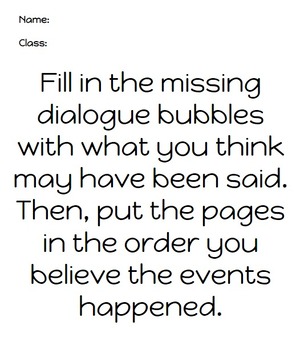Superman Smashes the Klan Sequencing Activity
Miss King's Kingdom
3 Followers
Grade Levels
6th - 12th, Higher Education, Adult Education, Homeschool
Subjects
Resource Type
Standards
CCSSRL.8.3
CCSSRL.8.9
CCSSRL.8.10
CCSSCCRA.R.1
CCSSCCRA.R.5
Formats Included
- Google Slides™
Pages
5 pages
Miss King's Kingdom
3 Followers

Made for Google Drive™
This resource can be used by students on Google Drive or Google Classroom. To access this resource, you’ll need to allow TPT to add it to your Google Drive. See our FAQ and Privacy Policy for more information.
Also included in
- Unit plan and resources for Superman Smashes the Klan by Gene Luen Yang. Can be adapted for other graphic novel or comic book units. This contains learning targets and MA English standards.Price $46.30Original Price $51.45Save $5.15
Description
This sequencing activity should be done before students have started reading Superman Smashes the Klan by Gene Luen Yang. Have students analyze the scene and fill in the missing dialogue as well as sort the pages in the correct order of events. Later, reveal the actual dialogue and order.
This activity can be assigned as a Google Slides activity or printed out.
Total Pages
5 pages
Answer Key
N/A
Teaching Duration
N/A
Report this resource to TPT
Reported resources will be reviewed by our team. Report this resource to let us know if this resource violates TPT’s content guidelines.
Standards
to see state-specific standards (only available in the US).
CCSSRL.8.3
Analyze how particular lines of dialogue or incidents in a story or drama propel the action, reveal aspects of a character, or provoke a decision.
CCSSRL.8.9
Analyze how a modern work of fiction draws on themes, patterns of events, or character types from myths, traditional stories, or religious works such as the Bible, including describing how the material is rendered new.
CCSSRL.8.10
By the end of the year, read and comprehend literature, including stories, dramas, and poems, at the high end of grades 6–8 text complexity band independently and proficiently.
CCSSCCRA.R.1
Read closely to determine what the text says explicitly and to make logical inferences from it; cite specific textual evidence when writing or speaking to support conclusions drawn from the text.
CCSSCCRA.R.5
Analyze the structure of texts, including how specific sentences, paragraphs, and larger portions of the text (e.g., a section, chapter, scene, or stanza) relate to each other and the whole.




